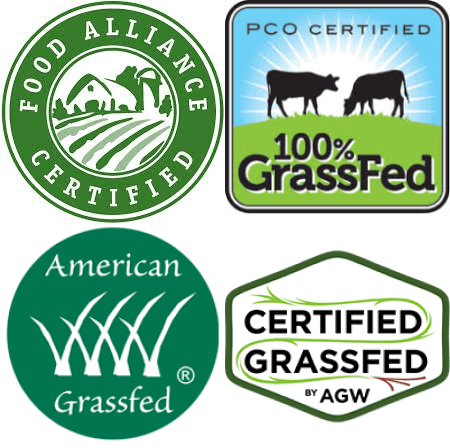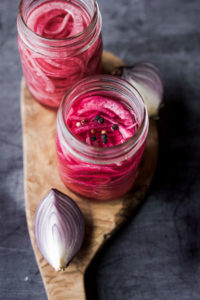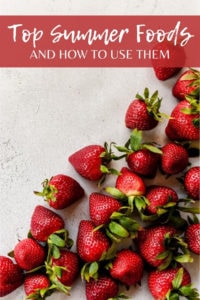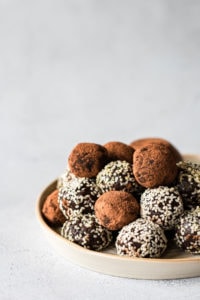
What exactly is grass-fed beef?
First off, let's make something clear: All cows are fed grass while they’re young, generally for the first two-thirds of their life. But once they reach a certain age (usually 6-12 months old), most cows are moved to a feedlot and transitioned to a grain-based diet.
So when we refer to grass-fed beef in this post, we’re talking about cows that eat grass throughout their entire lives, also known as grass-finished beef. When they’re weaned from their mother, they eat grass and whatever other green stuff they might find growing in the pasture.
When fresh grass isn’t available in winter, grass-fed cows eat hay, but otherwise they roam around freely in the pasture and graze. In this post we’re using grass-fed and grass-finished interchangeably.

Beefing Up with a Grain-fed Diet
In the US, it’s standard practice to allow cows to graze on grass for the first 6-12 months, before they’re weaned off of their mother's milk and grass and transported to a feedlot. At the feedlot, the cows are slowly transitioned to a new diet, consisting of a mixture of grains, some grass and other soy or corn substances.
By providing cows with calorie-dense food, the cows fatten up faster and are ready for slaughter sooner. That means more money, more quickly. The whole idea is to beef up the “product” faster, and maximize the profits.
Grass-fed beef tends to be more expensive because the cows are given adequate time to gain weight naturally. And it simply takes longer to get to the slaughterhouse on their natural grass diet. This results in higher costs for the farmer, and in turn, a somewhat higher price tag for the consumer.
It’s much easier to feed a large number of cows in a small area with a grain/corn-based diet, as you can simply fill tubs with feed for the cows to access at will. No need for pastures, no need for growing grass.
I’ll tell you what, when you have hundreds of cows, it’s pretty difficult to let them graze in a pasture. You’d need a lot more land to feed all those cows on an open pasture.
On a positive note, many feedlots create feed from distiller’s grain, among other items that would normally be thrown away. Although this helps reduce food waste, a cow’s stomach is designed for grass, not grains and corn.

Candy Bars for Cows - Is Grain Unhealthy for Cows?
Most farmers want the best for their cows, the cows are the farmer’s livelihood after all. And sick cows often result in lost money. Most feedlots have animal nutrition specialists who ensure the cows are receiving feed with the correct macronutrient ratios. But we still can’t overlook that a cow’s natural diet is grass.
As a ruminant animal, grass is what their stomachs were designed to digest. Some suggest if grain-fed cows lived out their lives naturally, they’d die very early due to their poor diet. Food choices causing health issues? That’s a new one!
Microorganisms in the cow’s rumen (one of their four stomach chambers) break down the grass and release nutrients that other animals (including humans) can’t digest. When feeding cows anything but grass and natural foliage, we end up with some unfortunate consequences…
A corn diet for a cow is about as beneficial as a candy bar for a kid.
Eating food their stomachs weren’t designed for can leave them susceptible to sickness. Which means higher rates of antibiotics, furthering the potential for antibiotic-resistant bacteria. It’s common to see antibiotics added to the feed in grain-fed cattle to help combat illness.
A corn-based diet may also increase the acidity in their rumen, causing heartburn and ulcers. It can get so bad for these cute cows that it can create liver abscesses.
There is concern that the acidic gut environments of grain-fed cows may increase the susceptibility for a cow to carry harmful bacteria like E. coli 0157:H7. The research is still mixed, but some studies suggest this acidic environment contributed to the development of an acidic-resistant strain of E.coli. Yikes...
When cows get sick, it’s common practice to put them back on a grass-based diet until their illness subsides. Grass is the best diet for a cow, and truly acts as medicine for them.
On a recent visit to a local farm and feedlot, our guide informed us that sick cows are often fed grass. He likened the grass-based diet to a salad which helps the cows feel better.
But greens aside, he said the cows LOVE the grain/corn-based diet because it’s so rich and tasty. Animals choosing calorie-dense food is not a new concept, it's how we evolved. If you give a child the choice between broccoli or candy, what do you think they’d choose? The same mentality is true when it comes to cows. More calories = better survival when food is scarce.

Grass-Fed vs. Organic Beef
Grass-fed and organic are not the same thing. Organic simply refers to whether or not the feed (grain and/or grass) was produced organically without synthetic fertilizers, pesticides or GMOs. In addition, the animals weren’t given any antibiotics, hormones or other drugs. Check out The Pros and Cons of Organic Foods for more information about organically-produced foods.
Organic practices can be good, but it doesn’t always mean the cows are grass-fed/finished. I should also point out that a farmer could have organic practices, but not have the certification.
Grazed and Confused - The Current State of Grass-fed Labeling
The current labeling of grass-fed or grass-finished beef is pretty unregulated and can be downright confusing. Organic doesn’t necessarily mean grass-fed and pastured-raised isn’t regulated. The label “grass-fed” doesn’t even necessarily mean it was fed grass throughout its entire life. Confusing for us too…
Here’s a great resource for deciphering USDA-regulated labels. You can also look for third party program seals that ensure stronger standards for outside regulation of grass-fed products. Here are a couple program seals that grass-fed/finished beef may display:

The labeling and certifications that are used to distinguish grass-fed and grain-fed cattle can be helpful, but there’s no substitution for knowing your farmer and all about his/her farming practices. Support your local farms that use good practices. It’s also possible that farmers may follow organic practices, but may not have the certification as many certifications cost extra money.
So get to know your farmer and ask them about the practices they use. It’s hard work to raise animals properly, so send them some love and support! Check out EatWild.com to find some farms in your area!
Nutritional Differences between Grass-Fed and Grain-Fed Beef
Grass-fed beef tends to be much leaner than grain-fed beef. In the interest of full disclosure, this also means the beef won’t be quite as juicy or tender. When cooking grass-fed beef, it tends to dry out quicker, so watch out for overcooking.
From a flavor standpoint, grass-fed beef will have less sweetness than grain-fed, and will take on flavors that reflect the local foliage. Some find it a bit gamier and meatier than grain-fed beef, but many don’t notice much of a difference at all.
Grass-fed beef has twice the levels of omega-3s 👍 when compared to grain-fed beef. Though grass-fed beef still isn’t a significant source of omega-3s, so be sure to incorporate other high-Omega-3 foods like cold water fatty fish (salmon/mackerel/anchovies), flaxseed walnuts, chia seeds, etc.
Grass-fed beef also has more beta-carotene, antioxidants like vitamin E and less cholesterol-raising fats than grain-fed beef.
Overall, grass-fed beef contains more beneficial nutrients than grain-fed beef, but the nutritional differences aren’t significant (beef is still beef). Keep in mind, grass-fed beef shouldn’t be a substitute for foods that are better sources of these nutrients. Carrots are still a better source of beta-carotene than grass-fed beef.

The Environmental Impact
There’s plenty of debate surrounding the questions of grass-fed beef and the impact on the environment. Our current food system is a large contributor to greenhouse gas emissions, with especially high levels from livestock.
One argument is that grass-fed beef contributes to higher greenhouse gas emissions because the cows live longer and in turn, burp, fart and poop more. Others argue that with grass-fed beef, the cows are roaming around throughout the pasture, so some of those greenhouse gasses from manure are sequestered back into the soil, thereby reducing the overall impact.
Another important point to discuss is the sustainability of grass-fed beef. With the amount of beef consumed per year in the U.S. It’s likely not realistic to continue that rate of consumption while only following grass-fed feeding principles or really any beef feeding principles.
If you’re really looking to reduce your environmental impact, consuming less meat would be a good place to start, both for your health and for the environment. No, you don’t need to become vegan or vegetarian, but a more plant-forward diet has been shown to be better for us and the planet alike.
The World Resources Institute recently came out with the report “Creating a Sustainable Food Future” which provides suggestions about how the future of food can meet growing demands from a growing population in a sustainable way. This report includes decreasing beef consumption, reporting that the US will have to decrease beef consumption by 40% to continue feeding the world’s growing population by 2050.

The Ethical Impact
Aside from the nutritional and environmental sides of the conversation, there’s also an ethical dilemma. The term grass-fed/finished only tells you about the feed. It doesn’t tell you whether the cow was roaming on a pasture or eating grass in a crowded feedlot (this is becoming more popular as the demand for grass-fed beef increases. Another reason to *cough* get to know your farmer *cough*).
Many choose to purchase grass-fed and pastured-raised beef because they feel the pasture-raised lifestyle is a whole lot nicer for the cow. Many argue the life of a feedlot cow is inhumane. Feedlots often pack several cows into a pen that’s covered in dirt, mud and manure with no green grass to be seen.
And although I pictured far worse conditions than I saw when visiting the feedlot, the cows in pastures seemed much more relaxed and at ease. The feedlot cows, with their dirty faces, quickly backed away as we approached. Whereas the cows in the pasture approached with curiosity as they basked in the sun chewing away on the fresh green grass.
Regardless of how you feel about the treatment of livestock, it’s important to acknowledge cows are living beings.

The Bottom Line
Although grass-fed beef tends to contain more beneficial nutrients, the nutritional differences aren’t significant, and the safety and environmental impacts are still hotly debated. So is grass-fed/finished beef worth the extra price? Well it depends on what’s important to you.
Although the nutritional differences are pretty minor, the way I see it - cows are living beings and should be treated properly.
They may not be the smartest, but they sure are cute and have their own vibrant personalities! It’s important to treat these animals humanely, and feedlots just aren’t beneficial for the cows or the environment.
The difference was clear to me when walking through feedlots and walking through pastures. The cows sure seem happier when they’re surrounded by grass, chewing and mooing the day away. For this reason, for the limited amount of beef we do purchase, I go out of my way to purchase grass-fed/finished, humanely raised beef. And by eating less meat and mostly plants, we can afford to spend a bit more when we do purchase meat.
P.S. Eating beef is not necessary for a healthy diet. As Michael Pollan states, "Eat food. Not too much. Mostly plants."
Now that you have the facts, I’d be interested to hear how it stacks up for you! Post your questions and comments below!
Need some recipe ideas for your grass-fed beef? Check out Grass-Fed Beef and Zoodle Pad Thai and our Thai Larb Bowl.






Leave a Reply